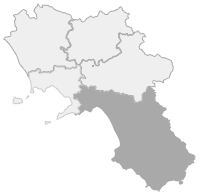It was clearly visible from every sanctuaries of the coast: from Heraion to the mouth of Sele in Poseidonia, to the ancient Pontecagnano. That place on the top of Costa Palomba, in the heart of the Alburni, today in the municipality of Sant’Angelo in Fasanella, was an essential stop for anyone moving to the Lucani lands.
To pay homage to the figure sculpted in relief on the large circular stone between the V and IV centuries BC, people had to climb a mount 1125 meters high. In the period of time when the territory belonged to Lucani, the top from which valley of Calore and the course of Fasanella were controlled, was fortified with mighty walls whose remains are still visible today. As is the figure carved in the rock, known as the Antece, the "ancient" or, perhaps the "immovable". A male figure, portrayed in life-size, about one meter and sixty in height, with open arms pointing to the west, wearing a tunic secured by a belt from which a sword hangs, while with his right hand he holds a spear and his shield is placed on the ground. It is likely that there was also a helmet on the head, before that part was damaged in the early twentieth century. And some signs suggest that the sculpture was originally inscribed in a circle. But who is this figure the ancient Lucani went to pay homage? Was that a famous warrior, a hero deserving of an eternal monument from the entire community? Or was he the god Alburno that Tertullian claimed was worshiped in that area? An altar or a basin located near the sculpture testifies that sacred rites were held on that site, in presence of priests, and with propitiatory animal sacrifices.
A sacred place, however, in an environmental context of extraordinary beauty, which accompanies the entire route, amidst rich vegetation, towards the Antece. From Sant’Angelo to the top of the mountain, a place full of suggestions and full of spectacular landscapes over the wonders of the internal Cilento and up to the coast.




Comments powered by CComment